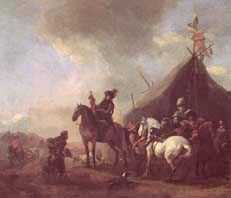Philips Wouverman, born in Harlem in 1619, was the son of Paul-Joosten Wouwerman, a modest painter from Alkmaar. He was to become one of the greatest Dutch painters of landscapes, battles and horses.

Philips Wouwerman
"A military encampment with a mounted
trumpetter and ather horsemen",
oil on panel | 
Philips Wouwerman
"An extensive landscape
with gentelman",
oil on panel |
Witnessing the fastuous life of rich Dutchmen and their surroundings, castles, feasts, hunting and stables, Wouwerman however never became a rich man after producing over 600 paintings during his career.
No other artist of his time knew how to represent military encampments, markets and stables as well as horses and horsemen in various attitudes against a background of beautiful landscapes.
At 19 Wouwerman abducted a young Catholic girl whom he married in Hamburg but instead of becoming a kind of galloping hero, like the horse riders he showed on his canvasses, he led a rather bourgeois life.
He worked for a while in Hamburg with Everard Decker and left in 1640 for Harlem where he was admitted in the Guild of Saint Luke. After becoming the pupil of Wynants the latter invested him with the task of painting horses and horsemen in his paintings.
Wouwerman, who died in 1668, idealised his subjects to the utmost painting the most beautiful horses that people could think of with much poetry. He seemed to know everything of the equestrian art representing details with great accuracy.
One should remember the major role horses played during the 17th Century not only in battles but also in daily life. He in fact represented a lost world with an acute eye and not horses as they were but as people wanted them to be. During the 18th Century, horse painters did not bother to exhale Wouwermans poetry and limited themselves to representing horses of all possible and even degenerate breeds.
His brother Pieter, born in 1623, was his pupil and painted many imitations of his works, though in a less brilliant manner. He died in 1682.
A second brother, Jan, born in 1629, was the pupil of Wynants and much copied his master to the extent that certain of his paintings have been attributed to the latter. He died in 1666.